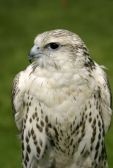 |
| Kingdom | Animalia |
|---|---|
| Phylum | Chordata |
| Class | Aves |
| Order | Falconiformes |
| Family | Falconidae |
| Genus | Falco |
| Size | Male length: 45 cm Female length: 55 cm Male wingspan: 100 – 110 cm Female wingspan: 120 – 130 cm Male weight: 730 – 990 g Female weight: 970 – 1,300 g |
Status
Classified as Endangered (EN) on the IUCN Red List 2006, and listed on Appendix II of CITES.
Description
A great favourite with falconers, the saker falcon is a large, powerful bird of prey with an exceptionally broad wingspan for its size . Like other falcons, this bird is equipped with sharp, curved talons for grasping prey, while the strong, hooked beak is used to tear its victim's flesh. Great variation in colour and pattern exist, ranging from a fairly uniform chocolate brown colour to a pale sandy colour with brown bars or streaks, to almost pure white individuals, which are particularly prized by Arab falconers. Females are markedly larger than males.
Range
The saker falcon is a wide-ranging species with a breeding distribution across the Palaearctic region from Eastern Europe to western China However, after the breeding season, many populations migrate for the winter to more southerly Asian countries such as India, as well as to the Mediterranean, Middle East, and parts of Africa.
Habitat
The saker falcon prefers open terrain for hunting, such as desert edge, semi-desert, steppes and arid montane areas . Nesting usually occurs in old abandoned nests of other birds on copses or cliffs, with nests having been recorded up to 5,200 m above sea level.
Biology
As the breeding season commences in spring, males begin to perform spectacular aerial displays as a form of courtship ritual to attract females, calling loudly as they soar over their territories. Saker falcons are generally two to three years old before they begin to breed, after which one brood of two to six eggs will be produced annually by the female. Chicks are able to fly after 45 to 50 days, but remain dependant on their parents for food for at least another 30 to 45 days, during which time they stay within the nesting territory.
The saker falcon can be both highly agile and extremely fast as it hunts close to the ground , capable of diving for prey at 200 mph . Prey consists largely of mid-sized mammals such as ground squirrels, rats, stoats and hares . At other times, and particularly near water, ground-dwelling and aerial birds such as pheasants, quail, ducks, herons and even other raptors(owls, kestrels) form a significant proportion of the diet . The saker falcon is a ferocious hunter and frequently attacks prey larger than itself
Threats
The saker falcon has undergone a rapid decline in recent years, particularly in the Middle East and Asia due to over-capture for the falconry trade, and now faces the very real threat of extinction. Of those captured for the falconry trade, the vast majority are thought to be juvenile females, creating a major age and gender bias in the wild population that dramatically reduces its breeding potential . Females are preferred by falconers due to their larger size and juveniles because they are easier to train than adults . In Europe, the saker falcon is mainly threatened by the loss and degradation of steppes and dry grassland habitat due to agricultural expansion and declines in sheep pastoralism, which has in turn reduced the availability of key prey species and suitable hunting ground. Across the bird's range, declines are also the result of human persecution and accidental poisoning through pesticides, which contaminate the falcon's prey . In some parts of its range, rodent plagues result in the extensive use of poisons to control them, causing the indiscriminate deaths of many raptors that feed on them .
Conservation
The saker falcon is protected across much of its range, particularly in Eastern Europe, where controls of illegal trade were implemented in various countries in the 1990s . There have been concerted conservation efforts in Europe, and intensive patrolling and management has even produced a steadily rising population in Hungary . The species is listed on Appendix II of the Convention on International Trade in Endangered Species (CITES), and in 2002 CITES imposed a trade ban on the United Arab Emirates. However, more needs to be done to monitor illegal trade, which evidently continues, and to enforce regulations against it. Certain countries, including the United Arab Emirates, have reduced the demand for wild-caught birds by captive breeding ‘farmed' saker falcons to trade to falconers instead. A number of research programmes have also been established to learn more about the distribution, population, and ecology of this species, in addition to the threats facing it, which should help to inform appropriate conservation efforts and management strategies in the future